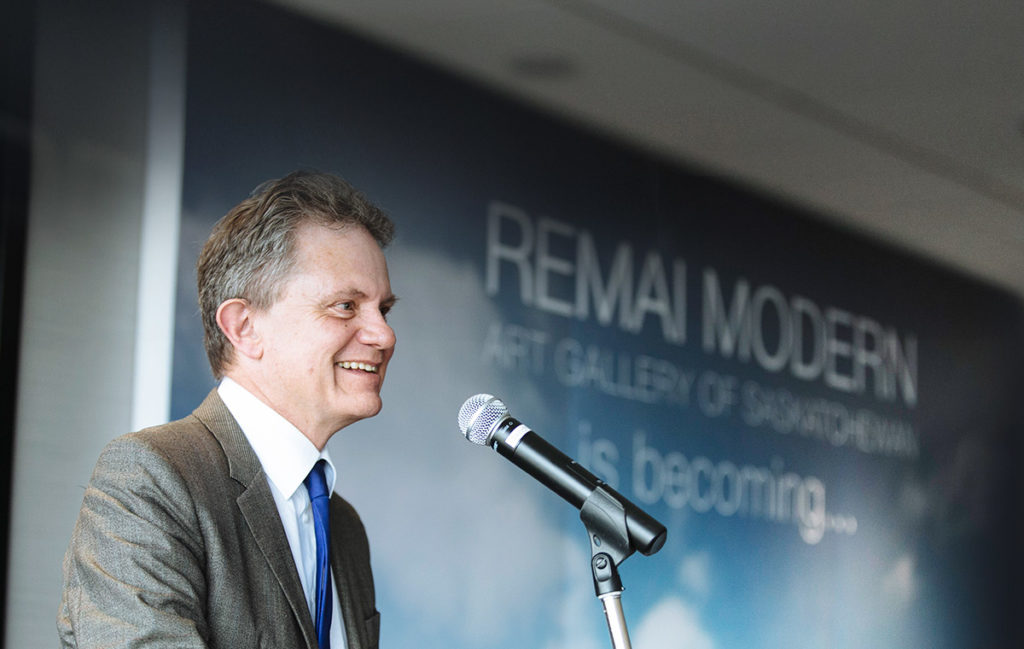Adam Art Gallery Director Christina Barton visits an old friend.
In October 2017, I was lucky enough to attend the opening of Canada’s newest art museum, the Remai Modern. Located in Saskatoon, a small city on the prairies of Saskatchewan (the closest major centre, Vancouver, is an hour-and-a-half away by air), it is an unlikely setting for a new institution dedicated to ‘affirming the powerful role that art and artists play in questioning, interpreting and defining the modern era’, as the institution’s press release boldly claims. But then those are just the kind of fighting words the museum’s executive director and CEO Greg Burke used in describing City Gallery Wellington and the Govett-Brewster Art Gallery in New Plymouth when he was curator at the former and director of the latter through the 1990s and early 2000s. Discounting artists, Greg is perhaps our most important art-world ‘export’, one of a rare breed of director-curators, whose first commitment is to contemporary art and artists, even as his career has taken him deep into the realpolitik of museum management and expansion, marketing, stakeholder development, and relentless fundraising.
I’ve stayed in touch with Greg since he left New Zealand in 2005 to take on the role of director at the Power Plant in Toronto, and have learnt from him how hard it is to lead an institution of any scale in North America. In Saskatoon, where he has been since 2013, Greg has been blessed with a benefactor of extraordinary generosity: Ellen Remai, a local entrepreneur, gave $30m in 2011 to create a new museum; donated her and her husband’s entire collection of 405 linocuts by Pablo Picasso (making this the largest holding in the world); and, on the eve of the opening on 21 October 2017, pledged a further $2m a year for twenty-five years for acquisitions, bringing her total donation to a staggering $103m. Greg is also cursed by the familiar local politics of any small town challenged by the imposition of a new state-of-the-art building (by leading Canadian architect Bruce Kuwabara of KPMB) designed to showcase modern and contemporary art (from elsewhere). The all-too-familiar questions—‘What about local Saskatchewan artists?’, ‘Where are the indigenous staff?’, ‘Why should the city have to cover cost overruns?’—were momentarily quietened on the opening weekend when townsfolk joined international and national guests to finally see inside the elegant L-shaped building on its site on a bend in the South Saskatchewan River.
With 130,000 square feet of space over four levels, a 150-seat theatre, outdoor terraces, dramatic atrium, café, and store, even an indoor fireplace (it’s cold in Saskatoon with winter temperatures falling below minus-30 degrees Celsius), the building is an airy and impressive container. Inside, critics and supporters were met with a suite of exhibitions that carefully answered their questions and had all the hallmarks of Greg’s strategic approach to programming: collection items were set alongside new commissions; historical works were recontextualised by contemporary practitioners; local artists were paired with international figures; a separate show of Native American artists was handed over to indigenous curators; the new Remai branding designed by the on-trend, New York–based Karlssenwilker, Inc. was everywhere apparent; attendance for the weekend was free (and will remain so for the ground-floor spaces); and bubbles flowed at the several opening parties. In other words, every aspect of the occasion was conceptualised and then carefully orchestrated.
I might have been one of the very few who detected echoes of Greg’s previous work as a curator and director in New Zealand. It’s here that he honed his practice and developed his world view, figuring out how to make the most of his off-centre location, indeed fearlessly imagining that you can be a great contemporary gallery anywhere. I think back to his opening programme at City Gallery Wellington in 1993, which mixed ambitious commissions (Jacqueline Fraser) with a politically-charged survey of feminist art (Alter/Image) and cutting-edge internationalism (Rosemarie Trockel), and to the large-scale theme shows (think Drive or Feature: Art, Life, and Cinema) and the unexpected pairings of international and local artists (like Christopher Williams and Peter Peryer) he masterminded in New Plymouth. I see the same agenda at work in Field Guide, Remai Modern’s big opening statement. There are even some of the same artists Greg first worked with here; for example, Pae White, Christopher Williams, and Rodney Graham (whose 1999 film work, How I Became a Ramblin’ Man, I still vividly remember watching in the Govett’s old cinema/auditorium).
Sometimes going to the edge gets you closer to the centre. Attending Remai Modern’s opening as Greg’s ‘old friend’ was a more meaningful and effective opportunity than rolling up to MoMA and expecting VIP treatment. I rubbed shoulders with ‘big’ names like Ryan Gander and Anthony Vidokle, talked Canadian politics (huh?) with Stan Douglas’s studio assistant at the artists’ dinner, had a long chat to the editor of Art in America, saw some great art, and got to hang out in the swanky new boardroom and the team’s workspaces. Greg even had time for coffee. But, best of all, I was reminded that the margins are poignant and telling locations from which to talk back to power, and that a viewpoint forged from the skewed perspective of a periphery can counter and contribute to the panorama that is contemporary art.
—Christina Barton
Christina Barton is Director of the Adam Art Gallery, Victoria University of Wellington. On 20 February, the Adam will open a solo show by Luke Willis Thompson, who featured in Field Guide, Remai Modern’s opening show. Greg Burke will be attending. Barton is grateful to the Chartwell Trust for the support to attend the Remai Modern opening.



